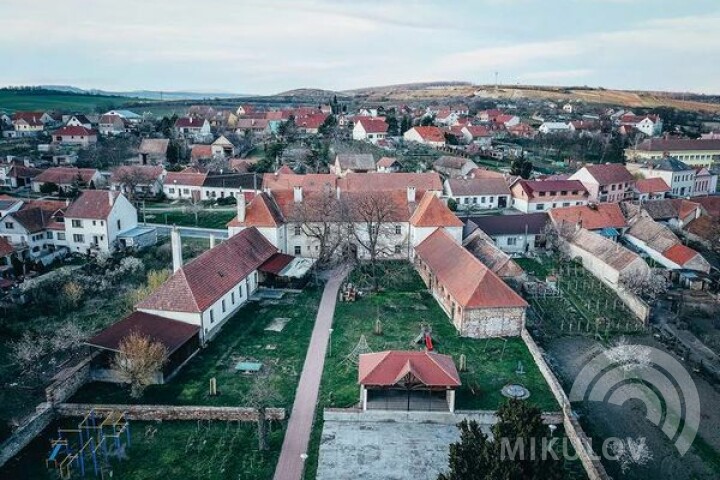The Mikulov, Portz Insel Project – Accessing and reconstruction of a designed historic landscape, was carried out by the City of Mikulov and its partners – the municipalities of Sedlec u Mikulova and Drasenhofen in Austria.
The preparation of the project already began in 2016, when numerous meetings were held with the affected
stakeholders, and subsequent preparatory steps were taken. In 2018 a subsidy for the project execution from the cooperation programme ‘Interreg V-A Austria-Czech Republic 2014–2020’ was approved. From September 2018 to June 2020 the project itself was carried out. Its main goal was to renovate and provide access to the historic brick bridge with 15 arches, as part of the cultural heritage site Portz Insel summer residence from the 17th century. Another access to the bridge was created through the renovation of the old road network in the municipalities of Mikulov – Sedlec u Mikulova – Drasenhofen.
The step provided the missing connection to the cycle path from Mikulov to Austria. No less important were further project activities, including the construction of an educational trail with five panels and resting points alongside the renovated roads to support effective visitor orientation, and the publication of a booklet about the historic locality and its restored heritage site.
Project preparation, cleaned bridge, May 2016
Photo: Ing Josef Hromek
Why the project was undertaken
The now completed project aimed to restore the historically valuable area extending south of Nový pond (New pond), in the locality of today’s peninsula named Portz Insel. It used to be part of the designed peri-urban landscape, whose development was commissioned by Franz Cardinal Dietrichstein in the 17th century. It was one of the earliest generously urbanized landscapes in Moravia and likely also in the larger territory north of the Alps.
There was a summer residence built on an island in Portz pond (today New pond) and complemented by flower arrangements and a forest park. The island complex, accessible over the long brick bridge supported by arched abutments and connected to the City of Mikulov through a two and a half kilometre long allée, originally an access road for carriages, was an extraordinary work of architecture of its time.
In the late 19th century it was still described by historians as a landscape jewel of unique beauty. However after 250 years from its completion, the designed landscape began to gradually succumb to deterioration as a result of draining of Portz pond in 1855 - its original area being approximately 100 ha2 - and the construction of the railway running across this land in 1872. In the mid-20th century the pond was partially renovated in its northern part, however after the border zone was established there, an almost complete decline of the original cultural landscape became inevitable.
Condition of the bridge before repair, year 2015
Photo: Ing. Josef Hromek
Sedlec near Mikulov
Situated about 2 km from there is the village of Sedlec u Mikulova. The settlement of Sedlec was first mentioned in the records from 1305. Sedlec lies in the area that was always at the centre of political and cultural events, which gave rise to constant conflicts and looting in war times. The history of Sedlec u Mikulova is connected with the owners of the Mikulov estate, the Liechtensteins and the Dietrichsteins, but also with the family holding the neighbouring estate Steinebrunn – the Fünfkirchens.

The original church, burnt down during the Hussite campaign through southern Moravia in 1424, was later repaired and around the mid-16th century rebuilt in the late Gothic style. In 1620 the church was devastated again by the Hungarian army lead by Bethlen Gabor. The church was then rebuilt in the Baroque style and in 1672 newly dedicated to St. Vitus.

Sulphur Baths - their history dates back to the year 1362. Sulphurous mineral waters treated various ailments, among them rheumatism or dermatological and neuralgia related problems. The period of prosperity was ushered in by Ferdinand Dietrichstein in 1669, when he built the first bath building here, and further developed by Karel Maxmilián Dietrichstein (1782), who built a modern spa complex in the Baroque style at the site. Shortly after the Second World War the spa was closed down.
Drasenhofen
Drasenhofen is a border town in the state of Lower Austria, Mistelbach District, and it also includes the communes of Kleinschweinbarth, Stützenhofen and Steinebrunn, the latter with a chateau Fünfkirchen, built in 1602. The present-day late Renaissance chateau is a four-winged, almost square-shaped building with four towers on the corner. Since 1972 the chateau has been in the ownership of the Fuhrmann family.
The life in the locality was significantly influenced by the so-called Vienna Road, connecting Vienna and Brno, which led through Drasenhofen. The great era of the road, also known as Imperial Road (Kaiserstrasse), was brought to an end in the mid-19th
century, when the old roads began to be replaced by the railway. Afterwards the former Imperial Road in Drasenhofen was changed into a ”wine cellar alley” (Kellergasse). Drasenhofen offers quite a few opportunities for hiking, as it is part of the Way of St James in Weinviertel area.


































































































